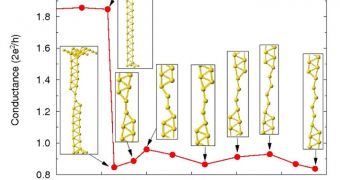Imagine a chain composed of a single type of atoms. For argument's sake, say that you are dealing with gold atoms. For many years, physicists and chemists have wondered how hard one has to pull with a specialized device on one of the atoms, so that it separates from the others of its kind. As the issue moves from theoretical science to the field of engineering, finding an answer to this question is becoming increasingly important. This is why researchers at the US National Institute for Standards and Technology (NIST) are conducting experiments, to create a device capable of measuring this.
The reason why engineers have arrived at the point where they need to know the answer to such questions is the fact that nanotechnology has progressed enormously over the past years. Features that were considered to be a thing of science-fiction are now hard realities, and the level of miniaturization at which researchers are currently working is too small for some to even fathom. Keeping in tune with these accomplishments, the NIST team is currently working on devising an instrument that could pull on a single atom from a chain of like atoms, with a precision level of 5 picometers. A picometer is equivalent to the trillionth part of a meter.
While looking for a place to start in constructing their new instrument, the NIST researchers turned their attention to the scanning electron microscope (STM), a device that can image single atoms. They then developed a probe made of pure gold, which ended in a very sharp, atomic-resolution tip. The probe is then approached to a flat, solid gold surface, until its tip bonds with one of the atoms on the target. Then, the experts pull on the newly-formed chain very easily, until they notice atoms beginning to separate. This type of investigation requires out-of-this-world position control, and that is why the NIST group worked to obtain the 5-picometer error rate.
In order to make things even more interesting, the team developed a method of stopping the probe from separating two gold atoms, when separation is about to occur. This allows scientists to measure the electrical conductance and stiffness of the wire, before eventually breaking it off and measuring its strength, PhysOrg reports.
“We’re after something that people that do this kind of measurement could use as a benchmark to calibrate their instruments without having to go to all the trouble we do. What if the experiment you’re performing calibrates itself because the measurement you’re making has intrinsic values? You can make an electrical measurement that’s fairly easy and by observing conductance you can tell when you’ve gotten to this single-atom chain. Then you can make your mechanical measurements knowing what those forces should be and recalibrate your instrument accordingly,” explains NIST engineer and physicist Douglas Smith.

 14 DAY TRIAL //
14 DAY TRIAL //